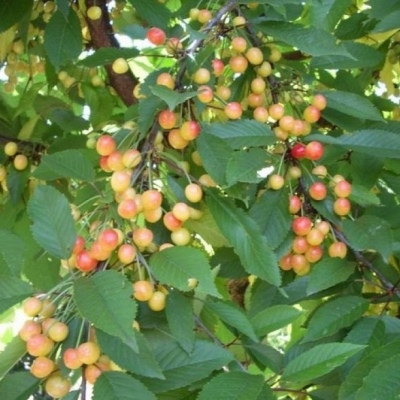
- Fruit shape: rounded
- Peduncle: medium thickness
- Authors: A.F. Kolesnikova, E.N. Dzhigadlo, A.A. Gulyaeva, Z.E. Ozherelyeva (All-Russian Research Institute of Breeding of Fruit Crops)
- Year of approval: 2010
- Growth type: medium-sized
- Appointment: dessert
- Yield: medium
- Tree height, m: up to 3.5
- Crown: pyramidal, flat, raised, medium density
- Escapes: medium, straight, brown
As a result of the work of domestic breeders, the sweet cherry variety Orlovskaya rozovaya was obtained. This hybrid was bred on the basis of the country's largest institution VNIISPK, whose representatives are engaged in the study of fruit and berry crops. The above variety was entered in the State Register in 2010.
Description of the variety
The maximum tree height is 3.5 meters. These are medium-sized plants with a pyramid-shaped crown. It is medium in density, flat and raised. The color of the branches is gray. Shoots grow straight, medium in thickness and brown.
The leaves have a typical oval shape, they are pointed at the base and apex. The color is dark green. During flowering, the tree is densely covered with snow-white narrow-pebbled flowers. Each inflorescence grows 4 buds. The diameter of the flowers is 2.2 centimeters. The ovaries are formed on last year's growths and bouquet branches.
Fruit characteristics
Sizes of medium fruits: width - 1.7 centimeters, height - 1.7 centimeters, thickness - 1.8 centimeters. The mass of berries is from 3.5 to 4 grams. The shape is standard round. The color is pink, thanks to which the variety got its name. Pink flesh is hidden under the skin, juicy and medium in density.
Fruits grow on stalks of medium thickness. The bone only weighs 0.16 grams. It detaches easily from the pulp.
If you make juice or compote from the fruit, it will be almost colorless.
Taste qualities
Sweet cherry Orlovskaya got a pleasant sweet and sour taste, and the tasting score was 4.4 points. The percentage of sugars - 15.49, acid - 0.71, dry matter - 22.4. The purpose of the berries is dessert.
Ripening and fruiting
The first crop is harvested only in the 3rd year after planting the seedlings. Flowering dates fall in mid-May (from 10 to 15). Due to the average ripening time, the fruiting period begins on July 15th.

Yield
The maximum yield is 107.2 centners per hectare of garden, and the average - 68.9 centners per hectare. To collect as many berries as possible, you need to plant trees in a suitable area and regularly care for them. The fruits are remarkably preserved due to their high transportability. The yield of the variety is average.
Self-fertility and the need for pollinators
Fruit culture Orlovskaya rosea is not capable of pollinating independently, therefore, the presence of pollinating plants is mandatory. Leave a gap of 3-4 meters between the plants. For the formation of fruit ovaries, it is necessary that the cherries bloom at the same time, otherwise the desired effect will not be achieved.
Among the wide variety of varieties, it is recommended to choose one of the following options for fruitful cherry varieties.
Pink pearls - attracts attention with the large size of the berries.
Poetry - characterized by burgundy fruits and medium ripening.
Orlovskaya amber - has a yellow crop color, sweet and large berries.
In memory of Chernyshevsky - the tasters rated the harvest at 4.8 points out of five.
Growing and care
2 years after planting the seedlings, they start feeding. For the first couple of years, the plants feed on fertilizers that are applied to the planting hole. They will be quite enough for the full development of the tree. Then nutrients are added every season.
Orlovskaya rosea reacts well to substances with a high nitrogen content. In early March, the culture is watered with a solution of urea or cow dung. To prepare it, it is enough to dissolve 30 grams of any of the components in 10 liters of water.
At the start of fruiting, a solution of potassium salt or superphosphate is used. The proportions are the same - 30 grams per 10 liters. During the autumn digging, 40 grams of potash dressings, 90 grams of phosphorus dressing and 10 kilograms of compost are added to the ground.
Sweet cherry belongs to moisture-loving crops, so it is watered 3-4 times throughout the year. For one young tree, 5 buckets will be enough; for adult plants, the volume is increased to 12 buckets. Trees especially need moisture during flowering, shortly before fruiting, and in the fall, during preparation for wintering.
It is advisable to combine watering with loosening. So the water will not stagnate in the soil, and the roots will receive the required amount of oxygen. Loosening promotes better absorption of minerals. In the process of work, the soil is dug to a depth of 10-15 centimeters. In the area of the trunk circle, weeds are removed.
Regular and correct pruning stimulates the growth of young shoots. As a result, the yield is significantly increased. The procedure should be carried out in the fall or spring, when the sap flow processes are suspended. When growing the Orlovskaya rose variety, gardeners are advised to form a tiered-sparse crown.
The process of full-fledged formation will take from 5 to 6 years. One layer includes 3-5 shoots. The distance between them is about 15 centimeters, and between the tiers - 0.5 meters. The rest of the growth is removed.
Preventive treatment is carried out annually to clear the tree of deformed and diseased shoots. It is also desirable to shorten the top to 3.5 meters. Work is performed only with a sharp and clean tool.





































































